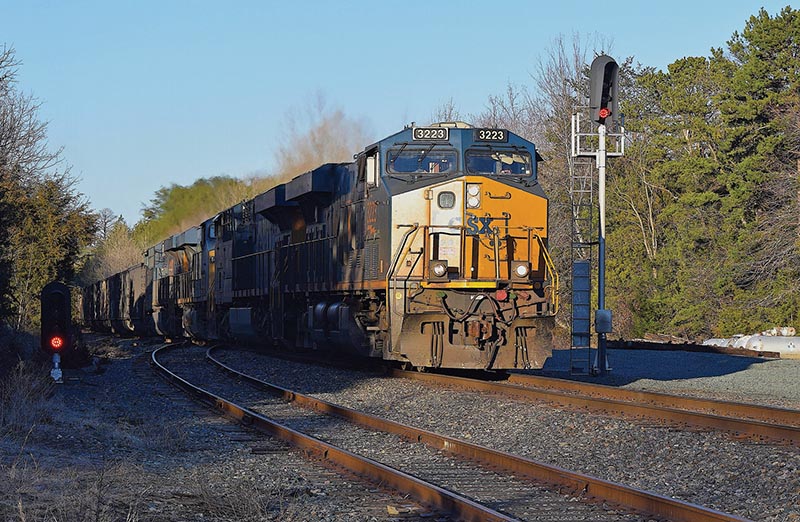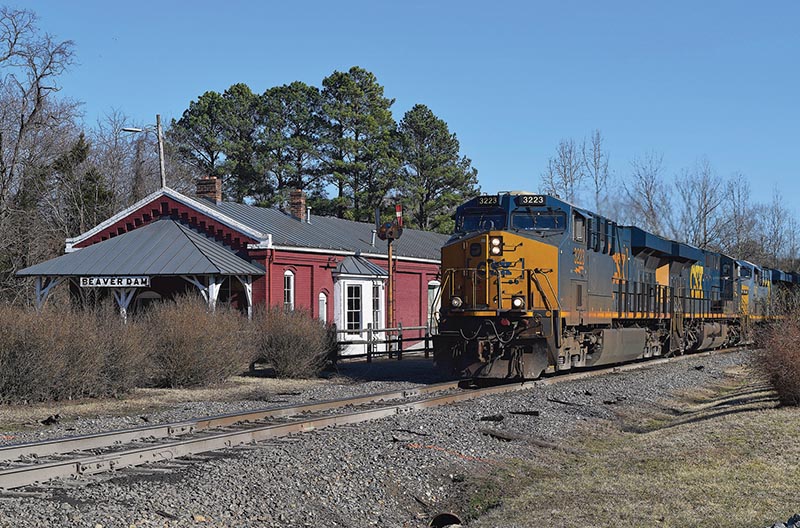 by Kurt Reisweber/photos by the author
by Kurt Reisweber/photos by the author
Spend a sunny Sunday afternoon following a westbound CSX empty hopper train returning from Newport News, Va., to the mines in West Virginia and Kentucky. The locations pictured are on the former Chesapeake & Ohio Piedmont and Washington Subdivisions, originally the Virginia Central Railroad, that is now operated for local freight by the Buckingham Branch Railroad. This trackage is used by most CSX westbound empty trains. This isn’t very well-known trackage, so enjoy a brief chase that took place on Sunday, February 23, 2025…

ABOVE: At Gordonsville the eastbound Amtrak Cardinal arrived on the scene, shown passing G Cabin and diverging northward onto the former C&O Washington Subdivision to Orange, where it enters trackage rights over NS (former Southern Railway) on its way to Washington, D.C. Former C&O G Cabin is no longer used by CSX, but it still stands tall in pristine condition. The last car on the train was an unusual Amtrak Baggage-Crew Dormitory, of which there are only ten in existence. Eastbound Train 50 (and its westbound counterpart Train 51) operates Sunday-Wednesday-Friday.

ABOVE: It was difficult keeping up with the slow-moving CSX hopper train between Beaver Dam and Gordonsville because of its length. It is necessary to cross the tracks at a few grade crossings and didn’t quite make it in time; then had to wait as two miles of hoppers went by. Fortunately the arrival of the Cardinal saved the day. After the tri-weekly passenger train cleared G Cabin, the westbound CSX empty train powered up and passed the junction.

ABOVE: Trains have to creep around the tight curve at the wye at Gordonsville, so it was no trouble beating the CSX westbound train to Lindsay, Virginia, despite the short distance involved. The shadows were lengthening by the time the train got there. Note the LED signals, used along the Buckingham Branch Railroad between Gordonsville and Clifton Forge, Virginia They are a relatively recent installation by the Buckingham Branch Railroad which now maintains this trackage. Lindsay was at one time the north end of the Virginia Air Line, which was used as a low-grade cutoff for C&O coal trains headed toward Washington and points northeast. The Virginia Air Line connected with the C&O James River line (former Richmond & Alleghany) at Strathmore, Virginia at its south end, and with the Main Line at Lindsay at its north end. Built in 1907-1908, it avoided the heavy grades between Charlottesville and Clifton Forge on the original C&O Mountain Subdivision. However, after being unused for a number of years, it was abandoned by the Chessie System in 1977-1978.



